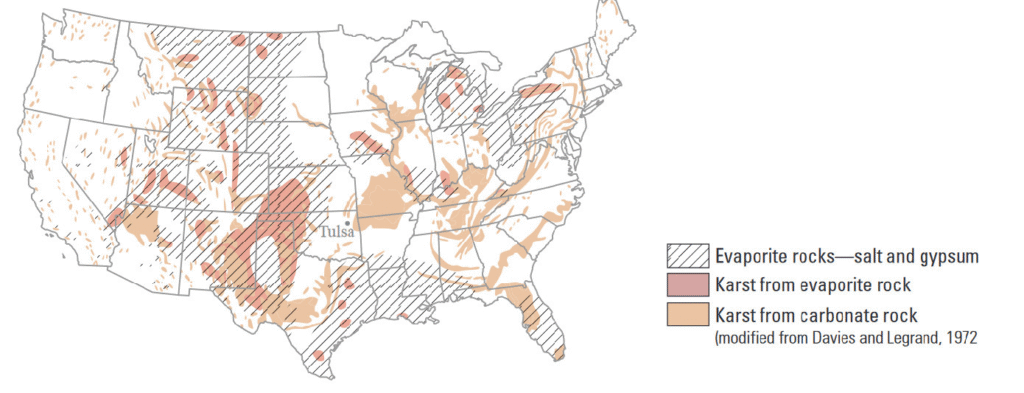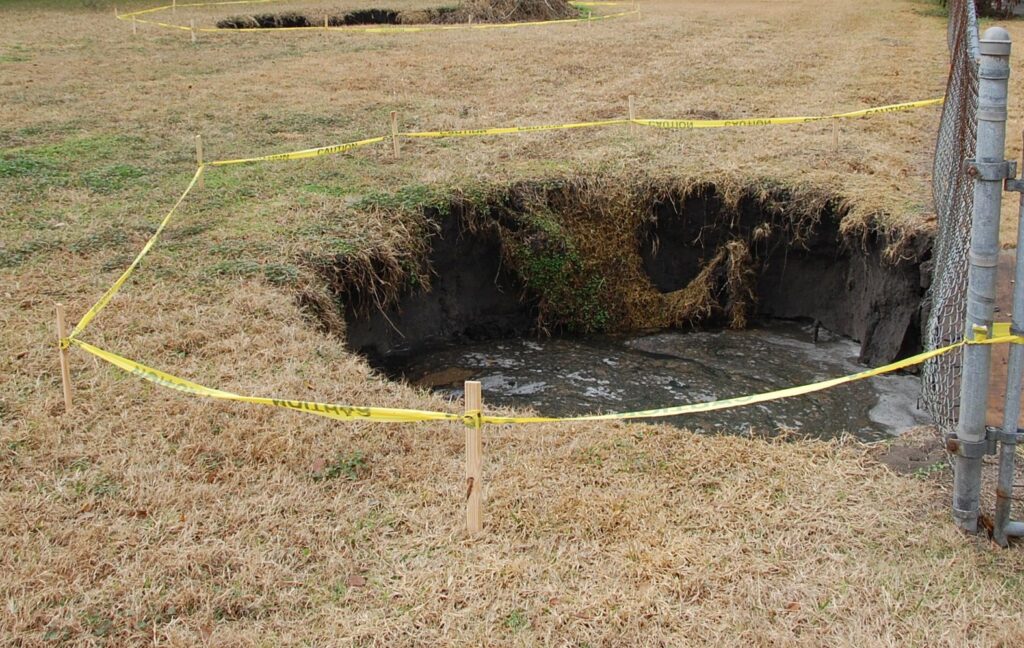Is That Really a Sinkhole? Expert Investigation Techniques for Ground Depressions
It’s a scenario we see frequently: a property owner discovers an unexpected depression or hole forming near their home or building foundation, and immediately envisions catastrophic outcomes. The infamous National Corvette Museum sinkhole in Bowling Green, Kentucky—where the museum floor collapsed and swallowed several classic cars—has become the mental reference point for many when they spot a hole developing on their property.
“When people see a hole developing in their yard next to their house, it can be scary and intimidating,” Geotechnical Engineer Matthew Slusser explains. “We’ll get calls from someone saying they’ve found a hole on their property, or from developers concerned about holes on a site they’re considering for a large warehouse or facility. Everyone wants to know: does this mean we have massive sinkhole problems?”
The answer, as with many engineering questions, is “maybe”—but not all ground depressions are true sinkholes, and many are surprised to learn that even genuine sinkholes can often be addressed with proper investigation and remediation techniques.
What Is a Sinkhole?
From an engineering and geological perspective, a sinkhole is specifically a condition that occurs when carbonate bedrock, such as limestone, erodes away as water travels through it. This process creates a void in the rock, and over time, the soil above it travels into that void, eventually creating a depression or hole at the surface.
This geological process is specific to areas with carbonate bedrock, particularly certain types of carbonate bedrock that are more susceptible to erosion. While dolomite and other related rock types can occasionally form sinkholes, limestone is the most common culprit in Kentucky and neighboring states.
But just because sinkholes do happen in Kentucky, that doesn’t mean it is what is causing the hole in your front yard.
Our Investigation Process: Determining What’s Really Happening
At CTL Engineering, our geotechnical engineers follow a systematic approach to investigating ground depressions:
Step 1: Geological Mapping Analysis
The first step in our investigation process is examining geologic mapping to determine if the site is in an area with limestone bedrock that could be susceptible to sinkhole formation. Fortunately, in Kentucky and many surrounding states, detailed geological mapping is readily available and provides invaluable information about subsurface conditions. These maps not only show us the underlying bedrock types but also indicate known karst areas and sinkhole-prone formations.
“Not all limestone is highly susceptible to sinkhole development,” Slusser explains. Different limestone formations have varying levels of susceptibility based on their mineral composition, Additionally, bedrock where the lithology (layering) changes between layers of limestone and layers of non-carbonate bedrock, such as shale, are less susceptible to karst activity.
In Kentucky specifically, geologists have classified areas into non-karst (where sinkholes don’t typically form), prone to karst (where they can develop), and intensely karst (where sinkholes are common). The St. Louis limestone and St. Genevieve limestone formations in western and central Kentucky are notorious for their intensive karst activity. This initial geological context helps CTL’s geotechnical team determine if sinkholes are likely. In downtown Louisville, Kentucky for instance, where the bedrock is up to 120 feet deep, sinkholes aren’t a problem.

Source: USGS
Step 2: Site-Specific Investigation
With geological context established, our engineers select the most appropriate investigation methods for the specific site conditions.
For potential sinkhole areas where the geology indicates limestone bedrock, CTL employs specialized techniques like electrical resistivity testing. This geophysical method is particularly effective at identifying voids in bedrock that could indicate developing sinkholes. Alternatively, for sites with shallow bedrock (less than 10 feet deep), sometimes the most direct approach is physical excavation to examine the bedrock surface directly and look for evidence of dissolution and void formation.
“Sinkholes typically don’t just occur on their own,” Slusser notes. “They’re usually occurring in a system, a chain, because water finds paths through the rock.” This understanding helps us evaluate the surrounding terrain for patterns of sinkhole activity that might indicate a connected underground drainage network.
For areas where the mapping indicates that sinkholes are unlikely, CTL focuses on other potential causes.
If It’s Not a Sinkhole, What Else Could It Be?
There are several other culprits that can cause sinkhole-like activity. One of the first steps for our team is to discover if a depression truly is a sinkhole or if there is another underlying cause.
- Underground Utility Issues: Cracked or leaking sewer pipes, water lines, or other underground utilities are common causes of ground depressions. When the pipe cracks it opens a void that can be filled with the soil above it, which eventually manifests as a surface depression.
- Abandoned Structures: Old cisterns, wells, or underground storage tanks that weren’t properly decommissioned can collapse over time. Especially on older properties where property records may not accurately reflect what is on the site, property owners may not know that the cistern or underground storage tanks previously existed.
- Buried Organic Material: Former burn pits where trees or debris were partially burned and then buried are surprisingly common, especially in former agricultural areas. Similarly, flooding events can deposit wood and organic debris that later gets buried in silt and clay. Over time, this material decomposes, creating voids that collapse.
- Poor Fill Placement: In developed areas, improper compaction of fill material during construction can leave voids. “If you’ve had a development where someone had to bring the grade up, and that fill was not placed with engineering quality control, it can have voids in it,” Slusser notes. These voids might not cause problems immediately, but can manifest years later as the material gradually settles or shifts.
- Animal Burrows: In some cases, what appears to be a concerning ground depression may simply be animal activity.
Understanding these alternative causes is important because the remediation approach differs significantly from sinkhole treatment methods.
Development of Appropriate Solutions
Once CTL has determined the actual cause of a ground depression, engineers can develop appropriate and effective remediation strategies tailored to the specific issue.
For genuine sinkholes in karst terrain, there are typically two main approaches. The first is plugging the throat of the sinkhole with concrete to prevent soil from traveling into the void below. The second approach is creating what’s called an “inverted filter.” This involves using different grades of crushed stone enveloped in fabric that allows water to move freely while preventing soil transport.
“Sinkholes are caused by moving water,” Slusser explains. “Whether that water rises and flows up and then flows back in, or whether it’s surface water soaking down through the soil and going through the rock, it’s caused by moving water carrying soil with it.” The inverted filter solution allows water movement while preventing soil migration, maintaining the natural drainage patterns of the site.
For depressions caused by utility issues, the solution might be as straightforward as repairing or replacing the damaged pipe. Other situations might require properly filling and compacting voids, removing organic material, or addressing improper fill placement with engineered solutions. Each remedy is specifically designed to address the root cause of the depression rather than simply filling the hole.
“The reason it’s important to understand what is causing the hole is that different techniques are going to work for different causes,” Slusser says.
Managing Sinkhole Risk in Karst-Prone Areas
In regions like western and central Kentucky, where the St. Louis and St. Genevieve limestone formations create mature karst landscapes, sinkholes are simply a fact of life. Despite these challenging geological conditions, development continues in these regions, and our engineers emphasize that sinkholes can be effectively managed with proper understanding and engineering approaches.
“A lot of times when you identify that you have a sinkhole on your property, people immediately think, ‘Oh no, my whole house is going to fall into this,'” Slusser said. “The reality is that it can happen, but we manage sinkholes all the time. There are massive industrial manufacturing facilities in the state that are built right over the top of sinkholes.”
And while sinkholes might seem intimidating, they’re a geological feature that experienced engineers have been successfully managing for generations in karst regions. With proper investigation and engineered solutions, even intensely karst areas can support safe development.
Why Professional Investigation Matters
While it might be tempting to simply fill a hole with stone or soil and consider the problem solved, our engineers strongly advise against this approach. “The reality is that might work for some situations, but it’s not going to work if you’ve got a large sinkhole.
Even worse, improper remediation can sometimes exacerbate the problem. “If you’ve got a hole in your sewer, and the stone that you’re putting in is small enough that it’ll go into the hole in your sewer—well, then it’s going to go somewhere, and you’re going to keep having problems,” our engineers explain.
Conclusion
If you discover a depression or hole on your property, professional assessment is the most reliable way to determine its cause and appropriate remediation. CTL Engineering’s geotechnical team has extensive experience investigating ground depressions throughout Kentucky and surrounding states, including areas with intensive karst activity.
The fact that a hole appears in your yard doesn’t necessarily mean you’re facing a catastrophic sinkhole situation. Many ground depressions have causes unrelated to karst activity, particularly in areas where the geology doesn’t support genuine sinkhole formation. Even in karst-prone regions, sinkholes can be effectively managed with proper engineering approaches.
Understanding what’s truly happening beneath the surface is the critical first step in addressing any ground depression. With proper investigation and engineering approaches, even properties in sinkhole-prone areas can be safely developed and maintained. Understanding the true nature of ground depressions is the first step toward effective management of these conditions.

